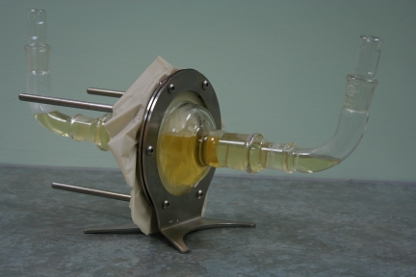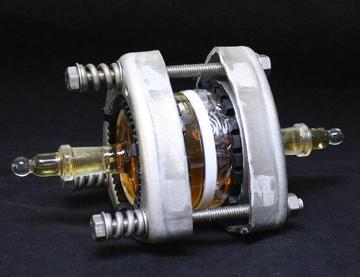Bacterial Barrier Testing
Wound dressings should be permeable to oxygen and water vapour but impermeable to microorganisms in order to promote optimum wound healing and prevent infection. Efforts have been made to develop a European Standard to assess the bacterial barrier properties of wound dressings, however, inter-laboratory studies yielded unreproducible results and identified leakage issues with the test apparatus, and therefore the draft standard method (prEN13726-5:2000) was not pursued.
 In the absence of a published standard, the SMTL have developed a bespoke test method to assess the bacterial barrier properties of wound dressings and other materials.
In the absence of a published standard, the SMTL have developed a bespoke test method to assess the bacterial barrier properties of wound dressings and other materials.
In this method, the test material is clamped between two flanged glass chambers, each filled with a liquid culture medium. A broth culture, containing a very small rod-shaped species of bacteria, is added to the fluid in one of the chambers and the apparatus incubated for a period of up to 7 days. During this time the culture medium is examined daily for evidence of bacterial transfer through the test material, as shown by turbidity of the liquid medium in the other chamber.
The test is usually run over a 7 day period, however this can be shortened or extended depending on the client's request.
The method has been refined over the 10 years since its initial conception, and the SMTL are now UKAS accredited for the bacterial barrier testing.
Bacterial barrier testing is available on a commercial basis, however, organisations wishing to perform their own testing may also purchase the apparatus from SMTL.
Viral barrier testing
Dressings

Viral barrier testing is performed in a similar way to the bacterial barrier, but a bacteriophage (virus that infects bacteria) is used as the inoculating organism. As the bacteriophage does not increase the turbidity of the broth, the broth is sampled and a plaque assay performed to detect the presence of bacteriophage which indicates passage of the phage through the sample. Bacteriophage Φ-X174 is chosen because of its small size (0.027µm in diameter). We have published an article about this method on medidex.com
Medical Gloves
SMTL is also developing a method for investigating the viral barrier properties of gloves, using the whole glove method.
If you have a product you wish to have tested for the permeability of bacteria or viruses, please contact smtl.biological@wales.nhs.uk.


